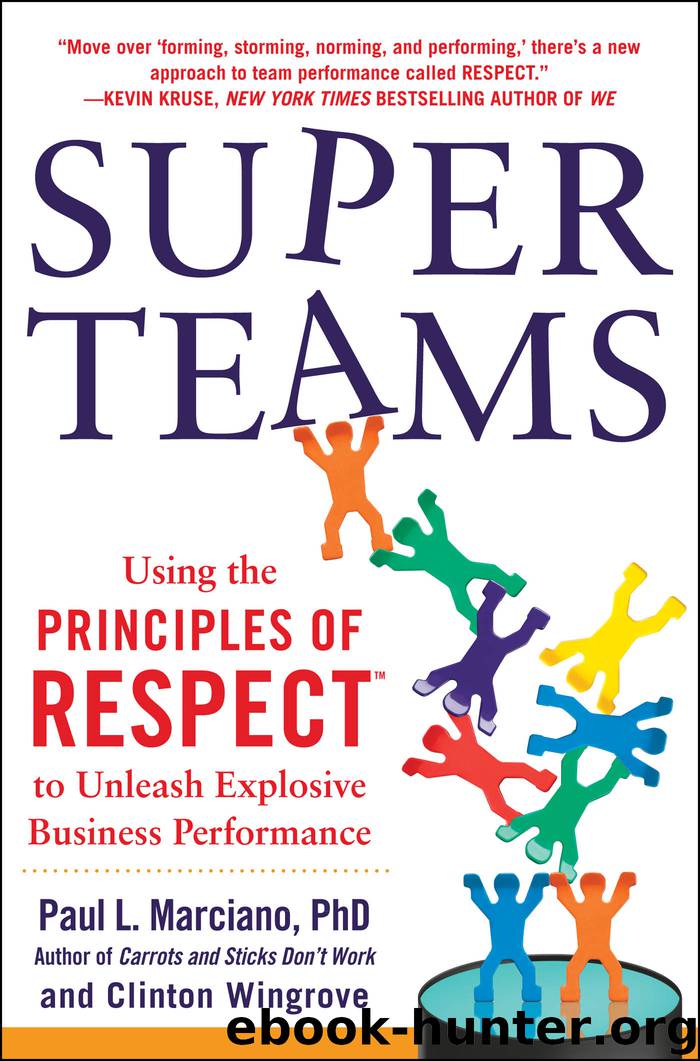SuperTeams by Paul L. Marciano

Author:Paul L. Marciano
Language: eng
Format: epub
Publisher: McGraw-Hill Education
Published: 2014-03-17T16:00:00+00:00
* * *
People don’t come together only because they need to; they also come together to achieve things because they want to. Choirs, dance troupes, golf clubs, and cycling groups are all examples of this. But does this mutual interest and a shared desire to succeed guarantee optimum success? Apparently not. Churches are closing by the hour. Most parent-teacher organizations struggle to retain active members, and many mutual-interest clubs degenerate as the “inner clique” starts to make the other members feel like outsiders. The same effect occurs in business, yet many organizations still seem to believe that buy-in is the magic ingredient, and they interpret buy-in and commitment to be exemplified by voluntary team membership. The increase in use of voluntary “focus groups,” “brown bag lunches,” quality circles, and other such teams has been explosive. But the desire by team members to be there cannot compensate for lack of clarity of purpose, having the right skills, and so on. It merely provides the source of energy and commitment.
With all the millennia of practice and decades of experience in our working in teams, wouldn’t you expect us to have refined how to make the different types of teams excel into an art form by now? No way.
It would appear that even with clear and shared team goals, singular team leadership, a defined team structure with clear team roles, agreed-upon team processes and rules, and quality communications, teams can and do still fail.
So is achieving SuperTeam status merely as simple as applying the RESPECT Model to teams that have at least met the conventionally agreed-upon standards? Probably not! The real challenge is identifying how to apply the RESPECT Model. We firmly believe that the RESPECT Model enables us to achieve SuperTeam status. But each different team type appears to require a different balance of the RESPECT drivers—just as every patient seeing a doctor needs a different combination of treatments. During our research, it became clear that the analysis of the teams that fail produces much clearer evidence of what is happening than the analysis of the teams that succeed. The diagnosis of why teams fail is really quite simple. Most fail because the people on the team simply can’t or don’t work effectively together.
Download
This site does not store any files on its server. We only index and link to content provided by other sites. Please contact the content providers to delete copyright contents if any and email us, we'll remove relevant links or contents immediately.
Bad Blood by John Carreyrou(6583)
Rich Dad Poor Dad by Robert T. Kiyosaki(6514)
Principles: Life and Work by Ray Dalio(6296)
Playing to Win_ How Strategy Really Works by A.G. Lafley & Roger L. Martin(6084)
Management Strategies for the Cloud Revolution: How Cloud Computing Is Transforming Business and Why You Can't Afford to Be Left Behind by Charles Babcock(4546)
The Confidence Code by Katty Kay(4220)
Thinking in Bets by Annie Duke(4185)
American Kingpin by Nick Bilton(3820)
Delivering Happiness by Tony Hsieh(3396)
Project Animal Farm: An Accidental Journey into the Secret World of Farming and the Truth About Our Food by Sonia Faruqi(3189)
The Power of Habit by Charles Duhigg(3095)
The Tyranny of Metrics by Jerry Z. Muller(3029)
Brotopia by Emily Chang(3026)
Mastering Bitcoin: Programming the Open Blockchain by Andreas M. Antonopoulos(3011)
The Marketing Plan Handbook: Develop Big-Picture Marketing Plans for Pennies on the Dollar by Robert W. Bly(3007)
I Live in the Future & Here's How It Works by Nick Bilton(2960)
The Content Trap by Bharat Anand(2888)
Applied Empathy by Michael Ventura(2864)
Building a StoryBrand by Donald Miller(2863)
